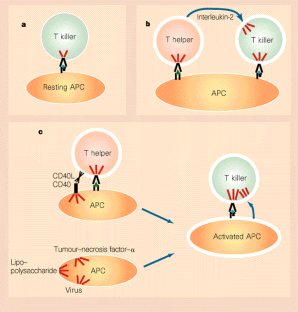Licence to kill (original) (raw)
- News & Views
- Published: 04 June 1998
Immunology
Nature volume 393, pages 413–414 (1998)Cite this article
- 2733 Accesses
- 7 Altmetric
- Metrics details
When the body's own cells become infected, the immune system can take the extreme step of killing them to preserve the rest of the organism. It is no surprise that this potentially dangerous mechanism has to be kept under strict control, and on pages 4741, 4782 and 4803 of this issue, three groups suggest a new mechanism by which this control operates.
The need for helpers and the nature of this help have intrigued immunologists for years. The first model (Fig. 1b) suggested that T-helper and T-killer cells recognize their specific antigens simultaneously on the same APC, and that cytokines (such as interleukin-2) produced by the activated T-helper cell would act on the T killer and facilitate its response4,5. Although interleukin-2 can substitute for helper cells in some systems, there are two main problems with this model. First, it requires that two rare antigen-specific cells meet on the same antigen-bearing APC — an event that has an extremely low probability. Second, and more importantly, some killer responses can be elicited in the absence of helper cells6, implying that the need for help is conditional rather than absolute.
This is a preview of subscription content, access via your institution
Access options
Subscribe to this journal
Receive 51 print issues and online access
$199.00 per year
only $3.90 per issue
Buy this article
- Purchase on SpringerLink
- Instant access to full article PDF
Prices may be subject to local taxes which are calculated during checkout
Additional access options:
Figure 1: Antigen-presenting cells (APCs) need a licence to help T-killer cells.

References
- Ridge, J. P., Di Rosa, F. & Matzinger, P. Nature 393, 474–478 (1998).
Article ADS CAS Google Scholar - Bennett, S. R. M. et al. Nature 393, 478–480 (1998).
Article ADS CAS Google Scholar - Schoenberger, S. P., Toes, R. E. M., van der Voort, E. I. H., Offringa, R. & Melief, C. J. M. Nature 393, 480–483 (1998).
Article ADS CAS Google Scholar - Keene, J. A. & Forman, J. J. Exp. Med. 155, 768–782 (1982).
Google Scholar - Mitchison, N. A. & O'Malley, C. Eur. J. Immunol. 17, 1579–1583 (1987).
Google Scholar - Buller, R. M., Holmes, K. L., Hugin, A., Frederickson, T. N. & Morse, H. C. Nature 328, 77–79 (1987).
Article ADS CAS Google Scholar - Guerder, S. & Matzinger, P. J. J. Exp. Med. 176, 553–564 (1992).
Google Scholar - Banchereau, J. & Steinman, R. M. Nature 392, 245–252 (1998).
Article ADS CAS Google Scholar - Sallusto, F. & Lanzavecchia, A. J. Exp. Med. 179, 1109–1118 (1994).
Google Scholar - Caux, C. et al. J. Exp. Med. 180, 1263–1272 (1994).
Google Scholar - Cella, M. et al. J. Exp. Med. 184, 747–752 (1996).
Google Scholar - Janeway, C. A. J Cold Spring Harb. Symp. Quant. Biol. 54, 1–13 (1989).
Google Scholar
Author information
Authors and Affiliations
- the Basel Institute for Immunology, Grenzacherstrasse 487, CH 4005, Basel, Switzerland
Antonio Lanzavecchia
Authors
- Antonio Lanzavecchia
You can also search for this author inPubMed Google Scholar
Rights and permissions
About this article
Cite this article
Lanzavecchia, A. Licence to kill.Nature 393, 413–414 (1998). https://doi.org/10.1038/30845
- Issue Date: 04 June 1998
- DOI: https://doi.org/10.1038/30845